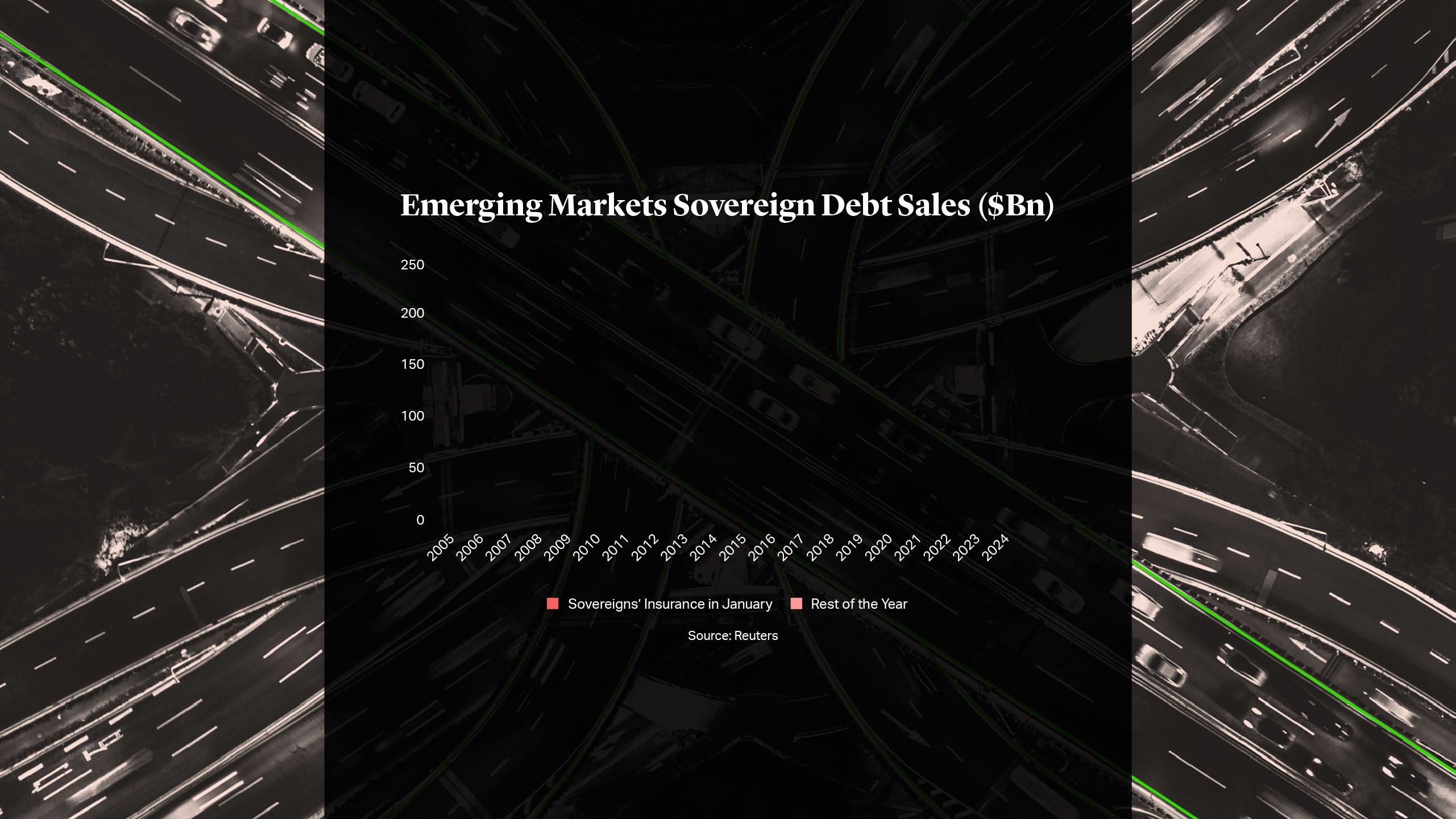






The first quarter of 2024 has seen record activity in emerging markets (EM) sovereign debt. January’s sales alone reached an unprecedented $47bn – led primarily by less risky sovereigns, including some big ticket issuances1. Cleary Gottlieb represented Mexico in its largest ever debt offering of $7.5bn at the start of the month2, for example.

By the end of Q1, high yield hard currency bonds were leading the way with 4.5% returns. This is compared to losses of 2% or more for investment-grade, EM local currency and U.S. Treasury bonds3. Overall, J.P. Morgan reported EM sovereigns sold more hard currency bonds than in any Q1 on record4, while Morgan Stanley analysts have predicted that $165bn of EM sovereign debt will be issued this year – roughly 20% more than in 20235.
In this article, we break down key features of this unprecedented first quarter.
The first quarter of 2024 has seen record activity in emerging markets (EM) sovereign debt. January’s sales alone reached an unprecedented $47bn – led primarily by less risky sovereigns, including some big ticket issuances1. Cleary Gottlieb represented Mexico in its largest ever debt offering of $7.5bn at the start of the month2, for example.

By the end of Q1, high yield hard currency bonds were leading the way with 4.5% returns. This is compared to losses of 2% or more for investment-grade, EM local currency and U.S. Treasury bonds3. Overall, J.P. Morgan reported EM sovereigns sold more hard currency bonds than in any Q1 on record4, while Morgan Stanley analysts have predicted that $165bn of EM sovereign debt will be issued this year – roughly 20% more than in 20235.
In this article, we break down key features of this unprecedented first quarter.



Domestic Versus Hard Currency
Hard currency EM sovereign bonds have been outperforming local currencies. J.P. Morgan’s overall foreign currency EM sovereign bond index has increased by 1.4% so far this year, compared to a 2.2% fall for EM local currency bonds6. Some of the biggest local currency falls happened in Chile, Turkey, and Thailand.
Certain EM sovereigns have bucked this trend, however. This includes Uruguay, which closed a UYU6.9bn offering represented by Cleary Gottlieb just after Q1 ended. Overall, the market sell-off of EM local currency bonds also remains limited7 – M&G points to the untapped potential within this section of the market. Mexican Bonos, for example, (which generally have lower yield volatility) currently offer a 5%+ yield8.

If the market continues its positive trajectory, the easing of monetary policies, greater capital, and improved investor confidence should also help to boost EM local currency bonds in the near future.
A Greater Appetite for Risk?
Despite high U.S. borrowing costs which often put investors off riskier economies, triple B (or lower) rated EM foreign currency sovereign bonds delivered a 4.9% total return for investors, compared to a 3.3% loss for U.S. Treasury bonds9. High yield issuers at the start of this year have included Oman, Turkey, Bahrain, and Colombia.
Many lower-rated sovereign bond issues have been trading at 10%+ – breaking with a 20-year norm and causing certain investors some anxiety. But is this a red flag for future debt distress across developing nations?
According to J.P. Morgan data, only 14 bonds from eight issuers were issued at above 10% during the previous two decades and nearly half defaulted10. Going back further though, from 1995 to 2004, U.S. treasury yields averaged over 5% and 120 bonds from 18 different sovereigns issued at 10%+. Out of these 120 bonds, only 20% defaulted11.
In this light, this 10%+ yield trend could be less of a red flag for investors, and instead signal their greater appetite for risk.


The Reopening of the Sub-Saharan African Market
This record first quarter for EM sovereign debt has also seen the reopening of the Sub-Saharan African Market.

Represented by Cleary Gottlieb, Côte d’Ivoire became the first Sub-Saharan nation to tap international capital markets in almost two years in January. Its $2.6bn issuance was also its first dollar issuance in seven years. In February, Benin – also represented by Cleary Gottlieb – sold its first-ever U.S. dollar bond, totaling $750mn at a 7.96% yield12. Kenya was among the high yield-rated African countries to return to international capital markets. Like other SSA issuers, the sovereign was empowered by cheap loans offered by the IMF and development banks13.
Meanwhile, higher commodity prices have empowered oil exporters – Nigeria raised almost $1bn with its recent Eurobond issuance, with Angola reportedly preparing for a similar value sale in the near future14.


A Greater Appetite for Risk?
Despite high U.S. borrowing costs which often put investors off riskier economies,
triple B (or lower) rated EM foreign currency sovereign bonds delivered a 4.9% total return for investors, compared to a 3.3% loss for U.S. Treasury bonds9. High yield issuers at the start of this year have included Oman, Turkey, Bahrain, and Colombia.
Many lower-rated sovereign bond issues have been trading at 10%+ – breaking with a 20-year norm and causing certain investors some anxiety. But is this a red flag for future debt distress across developing nations?
According to J.P. Morgan data, only 14 bonds from eight issuers were issued at above 10% during the previous two decades and nearly half defaulted10. Going back further though, from 1995 to 2004, U.S. treasury yields averaged over 5% and 120 bonds from 18 different sovereigns issued at 10%+. Out of these 120 bonds, only 20% defaulted11.
In this light, this 10%+ yield trend could be less of a red flag for investors, and instead signal their greater appetite for risk.


The Reopening of the Sub-Saharan African Market
This record first quarter for EM sovereign debt has also seen the reopening of the Sub-Saharan African Market.

Represented by Cleary Gottlieb, Côte d’Ivoire became the first Sub-Saharan nation to tap international capital markets in almost two years in January. Its $2.6bn issuance was also its first dollar issuance in seven years. In February, Benin – also represented by Cleary Gottlieb – sold its first-ever U.S. dollar bond, totaling $750mn at a 7.96% yield12. Kenya was among the high yield-rated African countries to return to international capital markets. Like other SSA issuers, the sovereign was empowered by cheap loans offered by the IMF and development banks13.
Meanwhile, higher commodity prices have empowered oil exporters – Nigeria raised almost $1bn with its recent Eurobond issuance, with Angola reportedly preparing for a similar value sale in the near future14.
Positive News for Investors
In many ways, the first quarter of 2024 and the record activity we have seen reflect the global economy’s surprising resilience in uncertain times.
Inflation is trending downwards, interest rates are set to drop, and EM economies are generally getting stronger – with certain national policies proving particularly popular with investors.
After returning to investment grade in late 2023, Greece’s April 2024 bond issuance received its second largest orderbook15. Pakistan’s new government and Argentina’s austerity measures have also demonstrably boosted investor confidence in both nations’ sovereign bonds.
Significant support from the IMF and other official creditors in recent months has helped make many sovereign debt defaults less likely too. Sri Lankan, Ghanaian, and Zambian dollar bonds all delivered double-digit returns this year, as the sovereigns enter the final phases of IMF-supported restructurings16.
In this environment, a positive feedback loop could be forming. As greater liquidity strengthens lower-rated sovereigns, this, in turn, should bring greater investment to the market.

Positive News for Investors
In many ways, the first quarter of 2024 and the record activity we have seen reflect the global economy’s surprising resilience in uncertain times.

Inflation is trending downwards, interest rates are set to drop, and EM economies are generally getting stronger – with certain national policies proving particularly popular with investors.
After returning to investment grade in late 2023, Greece’s April 2024 bond issuance received its second largest orderbook15. Pakistan’s new government and Argentina’s austerity measures have also demonstrably boosted investor confidence in both nations’ sovereign bonds.
Significant support from the IMF and other official creditors in recent months has helped make many sovereign debt defaults less likely too. Sri Lankan, Ghanaian, and Zambian dollar bonds all delivered double-digit returns this year, as the sovereigns enter the final phases of IMF-supported restructurings16.
In this environment, a positive feedback loop could be forming. As greater liquidity strengthens lower-rated sovereigns, this, in turn, should bring greater investment to the market.


Red Flags for the Future?
Despite record sales, some commentators fear lack of investment flowing into dedicated EM debt funds could put the brakes on any recovery.

Q1 saw $10.1bn net leave dedicated EMD funds globally – with $5.7bn and $4.4bn outflows from hard currency and local currency funds, respectively17. Meanwhile, by early May, U.S. high-yield debt funds had already had net inflows of $2bn18.
It is not uncommon for improved returns on U.S. and European bonds to lure investors away from emerging markets. More concerningly, higher U.S. and EU yields also make restructuring hard currency EM sovereign bonds more expensive – increasing risks of future defaults.
U.S. interest rates are also likely to settle well above pre-COVID levels – further cementing risks of debt distress for many EM sovereign issuers19. The unprecedented Q1 activity comes against a backdrop of huge geopolitical uncertainty as well, and a flurry of global elections which could have untold market consequences.
Overall, the high level of activity in EM sovereign debt markets reflects a stronger than expected global economy. It brings much-needed liquidity into the market, offering relief to some of the world’s poorest economies, still struggling with the aftermath of COVID-19. At the same, issues like higher interest rates and lack of flows into dedicated funds could be storing up future problems, while the rise of 10%+ yields is causing concern for some investors – alongside the shadow of ongoing geopolitical uncertainty.


Red Flags for the Future?
Despite record sales, some commentators fear lack of investment flowing into dedicated EM debt funds could put the brakes on any recovery.

Q1 saw $10.1bn net leave dedicated EMD funds globally – with $5.7bn and $4.4bn outflows from hard currency and local currency funds, respectively17. Meanwhile, by early May, U.S. high-yield debt funds had already had net inflows of $2bn18.
It is not uncommon for improved returns on U.S. and European bonds to lure investors away from emerging markets. More concerningly, higher U.S. and EU yields also make restructuring hard currency EM sovereign bonds more expensive – increasing risks of future defaults.
U.S. interest rates are also likely to settle well above pre-COVID levels – further cementing risks of debt distress for many EM sovereign issuers19. The unprecedented Q1 activity comes against a backdrop of huge geopolitical uncertainty as well, and a flurry of global elections which could have untold market consequences.
Overall, the high level of activity in EM sovereign debt markets reflects a stronger than expected global economy. It brings much-needed liquidity into the market, offering relief to some of the world’s poorest economies, still struggling with the aftermath of COVID-19. At the same, issues like higher interest rates and lack of flows into dedicated funds could be storing up future problems, while the rise of 10%+ yields is causing concern for some investors – alongside the shadow of ongoing geopolitical uncertainty.

